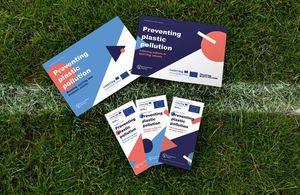UK: Sports industry urged to kick plastics out of sport
The Environment Agency is releasing new guidance encouraging the sports industry to kick plastics out of sport.
Olympic gold medallist Hannah Mills today joined the Environment Agency in calling on sport organisations across the country to ramp up efforts to tackle plastic waste.
New advice about reducing avoidable plastic waste at events and stadiums is being given to sports clubs, venues and event organisers across England as part of a drive to prevent plastic pollution.
Around 12 million tonnes of plastic enter our environment each year – that’s equivalent to a bin lorry load every minute. Of all plastic produced, 50% is for single-use plastic items, which are used for only a few minutes before being thrown away. It is estimated that major sporting events can generate up to 750,000 plastic bottles apiece.
The Environment Agency’s guidance invites the sports industry to address avoidable plastics by introducing water refill stations, minimising food packaging, providing more recycling bins and more.
The guidance also signposts people to the Big Plastic Pledge website – a global campaign founded by Tokyo 2020 Olympic sailing champion Hannah Mills – that aims to tackle the issue of plastic waste and eradicate single-use plastic in sport.
Hannah Mills said:
By harnessing and unifying communities by the power and reach of sport, through the athletes, events, fans, > volunteers and brands, the lasting impact is almost unimaginable.
I encourage everyone to make a pledge to reduce their single-use plastic consumption via the Big Plastic >Pledge.
Project lead Hannah Amor, from the Environment Agency’s plastics and sustainability team, said:
Experts tell us that 50% of all plastic produced is for single-use items – things that are used for only a few moments and then thrown away. This is having a detrimental impact on our planet.
The sports industry is in the unique position of being able to influence millions of people worldwide by leading the way in sustainability and setting a good example.
By minimising avoidable plastic consumption, the industry can help reduce the impact of plastic on our planet, reduce its carbon footprint and contribution to the climate crisis – possibly saving money at the same time.
Through the guidance, readers can also find out about challenging suppliers, the waste hierarchy (avoid, reduce, reuse, recycle) and the journey/lifecycle of a plastic bottle.
Plus, there are case studies detailing how organisations achieved their goals to reduce avoidable plastic, including an example from the New Forest Marathon, which replaced plastic drinks bottles for runners with cardboard cups which are collected and recycled. Runners dropping rubbish outside designated zones are disqualified for littering to communicate the importance to participants.
Andy Daish, Event Director at the New Forest Marathon, said:
Every event organiser has a responsibility to protect the environment they use. Furthermore, we are blessed with a perfect platform to communicate these key messages to those who visit the event.
The New Forest Marathon is passionate about protecting the wonderful and diverse habitat and raise awareness of wider environmental issues. We work closely with key stakeholders to ensure we have zero impact on the local habitat, and hope the event plants a seed for wider behavioural change.
Ceri Rees, Director at event organiser Wild Running, said:
We are encouraging our participants to take responsibility for bringing their own collapsible cups as part of their race kit, to eliminate wastage on feed station cups. We should all be in this for the long run, and hold event organisers accountable for their race equipment.
Barry Hopkins, Director at Sporting Events UK, commented:
We have been looking at our carbon footprint and our plastic waste over the last few years. We have been using reusable timing chips, with low plastic content, which can last for hundreds of thousands of active scans. Many of our signage items are produced in such a way that we can reuse them at future events.
As an industry it is important that we use best practice to help each other and drive forward initiatives to reduce waste, in particular the plastics used. We continue to engage with all our suppliers to see how they can reduce plastic waste in their supply chains, and be more eco-friendly in their approaches.
The new guidance has been produced on behalf of the Interreg Preventing Plastic Pollution (PPP) project, a cross-Channel partnership of 18 expert organisations, which identifies and targets plastic hotspots, implements effective solutions and alternatives, and embeds behaviour change in local communities and businesses.
The PPP project supports the Environment Agency’s ambition to promote better environmental practices that result in a reduction of plastic waste, helping to achieve the goals and commitments outlined in its EA2025 five year plan to create better place for people, wildlife and the environment, and the government’s 25 Year Environment Plan.
Scientists have found plastic everywhere, from Everest (the highest point on earth) to the Mariana trench (the deepest point on earth). Plastic has even been found in the Arctic and Antarctic.
Wildlife of all sizes have been found to eat plastic and get tangled in it. Ongoing research has also found that humans consume plastic and breathe it in during our day to day lives.

